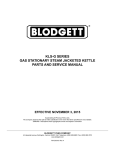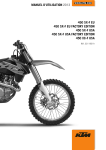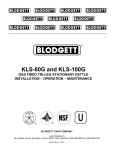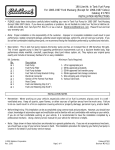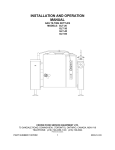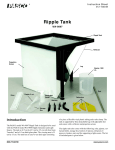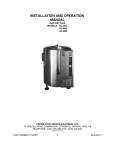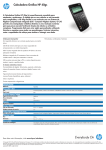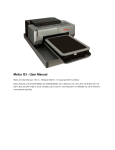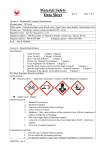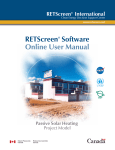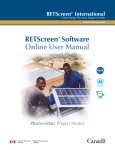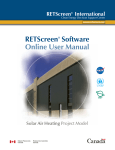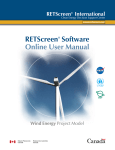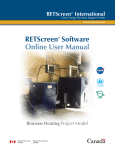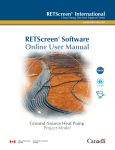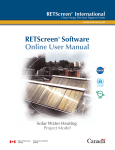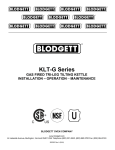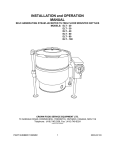Download Part List - Blodgett Oven
Transcript
KLT-40GS SHORT HEIGHT GAS TILTING KETTLE PARTS AND SERVICE MANUAL EFFECTIVE APRIL 24, 2015 Superseding All Previous Parts Lists. The Company reserves the right to make substitution in the event that items specified are not available. ERRORS: Descriptive and/or typographic errors are subject to correction. BLODGETT OVEN COMPANY 44 Lakeside Avenue, Burlington, Vermont 05401 USA Telephone: (802) 658-6600 Fax: (802) 860-3732 www.blodgett.com P/N S00158 Rev A TABLE OF CONTENTS GENERAL. . . . . . . . . . . . . . . . . . . . . . . . . . . . . . . . . . . . . . . . . . . . . . . . . . . . . . . . . . . . . . . . . . . . . . . . . . . . . . 3 MANIFOLD PRESSURE. . . . . . . . . . . . . . . . . . . . . . . . . . . . . . . . . . . . . . . . . . . . . . . . . . . . . . . . . . . . . . . . . 3 THERMOSTAT.. . . . . . . . . . . . . . . . . . . . . . . . . . . . . . . . . . . . . . . . . . . . . . . . . . . . . . . . . . . . . . . . . . . . . . . . . 3 PRESSURE SWITCH. . . . . . . . . . . . . . . . . . . . . . . . . . . . . . . . . . . . . . . . . . . . . . . . . . . . . . . . . . . . . . . . . . . 3 ADDING WATER (LOW WATER LIGHT COMES ON). . . . . . . . . . . . . . . . . . . . . . . . . . . . . . . . . . . . . . 4 RE-ESTABLISHING VACUUM.. . . . . . . . . . . . . . . . . . . . . . . . . . . . . . . . . . . . . . . . . . . . . . . . . . . . . . . . . . . 4 TROUBLESHOOTING.. . . . . . . . . . . . . . . . . . . . . . . . . . . . . . . . . . . . . . . . . . . . . . . . . . . . . . . . . . . . . . . . . . 5 MATERIAL SAFETY DATA SHEET.. . . . . . . . . . . . . . . . . . . . . . . . . . . . . . . . . . . . . . . . . . . . . . . . . . . . . . . 7 APRIL 24, 2015 2 KLT-40GS SERVICE INFORMATION GENERAL The major difficulties caused by pressure switch mis-adjustment are: When any difficulty arises always check that the unit has been connected to the gas supply type and voltage for which it was supplied. This can be done by examining the serial plate on the lower right side of the unit. It will list the gas type and voltage for which the unit was manufactured. 1. Pressure relief valve opening, pressure rises above 45 psi. 2. Pressure in kettle is less than 30 psi and burner is being shut down by pressure switch (not thermostat). The pressure switch is preset for proper operation from the factory. It is adjusted to the maximum pressure which will prevent the pressure relief valve from opening. During preheat to the maximum thermostat setting (275°F), from either a cold condition or a lower temperature setting, the temperature may overshoot the thermostat setting and be shut down by the pressure switch. This is normal, however, after the kettle has cycled several times (empty) the thermostat will begin cycling the unit. Wiring diagrams for the unit are located in a small envelope affixed to the side panel of left hand console. ORIFICE SIZE TOTAL INPUT 125,000 BTU/Hour NATURAL PROPANE DMS # 4 (.209") DMS # 20 (.161") MANIFOLD PRESSURE Natural Gas - 3.5 inches W.C To Adjust Pressure Switch LP Gas - 4 inches W.C. The thermostat adjustment should not be changed. Check the following before changing the thermostat. 1. To obtain access to the pressure switch, the front panel must be removed. Remove the screws on bottom of the panel. Be sure to support the panel to avoid excessive strain on the wiring. 1. With kettle cold, the pressure on the pressure gauge should read in the green vacuum zone (25 to 30 inches Hg vacuum). If not, see ‘Re-establishing Vacuum” section. 2. To increase the pressure switch setting, turn the white ribbed knob clockwise; to decrease, turn it counterclockwise. Use the centre of the black ring as an indicator. 2. The pressure switch may be set too high or too low and causing the out of adjustment condition. A voltmeter should be used by a properly trained serviceman to determine if the pressure switch or thermostat is actually cycling the burners. If the pressure switch is found to be cycling the burners, see “Pressure Switch” section. 3. With the kettle empty and completely cold, turn kettle on and set thermostat to maximum setting (275°F). After verifying that the pressure switch is set and operating properly, To set thermostat, adjust the trim-pot on the control inside the kettle. It is located next to terminal 2 and is not sealed. Turning pot clockwise will lower the temperature setting, counterclockwise increases temperature. At maximum setting, the thermostat should cycle off at a gauge pressure reading of 30 psi. Turn set screw clockwise to decrease pressure and counterclockwise to increase pressure. 5. Relief valve should not open when kettle pressure is 45 psi; pressure switch setting is satisfactory. PRESSURE SWITCH 8. Allow the kettle to cycle several times to verify the correct pressure setting. THERMOSTAT 4. The pressure in kettle (read pressure gauge on front panel) should reach a maximum of 30 psi and pressure relief valve should not open. Kettle pressure may rise 3 or 4 psi even after burners shut down. 6. If the safety relief valve opens, reduce setting on pressure switch, cool kettle completely by running cold water through it and repeat steps 3 - 6. 7. If pressure in kettle is below 30 psi increase setting of pressure switch, cool kettle completely by running cold water through it and repeat steps 3 - 7. The pressure switch should not be adjusted until it is determined to be the cause of an operating pressure difficulty. See “Thermostat” section to determine if the source of difficulty is the pressure switch or thermostat. APRIL 24, 2015 9. Replace the front panel when adjustment is complete. 3 KLT-40GS SERVICE INFORMATION ADDING WATER (LOW WATER LIGHT COMES ON) CAUTION!! It may be necessary to replenish water in the jacket when the low water indicator comes on. Do so as follows: Under normal operating conditions a “try lever test” should be performed every two months. Under severe service conditions, or if corrosion and/or deposits are noticed within the valve body, testing must be performed more often. A “try lever test” should also be performed at the end of any non-service period. 1. Unit should be completely cold and off. 2. Lift handle of pressure relief valve to release vacuum in kettle. (Relief valve is at right rear of kettle. 3. Remove air vent nut on the tee located next to the relief valve. CAUTION!! 4. Using pure distilled water only, pour the water into the opening (a funnel will be helpful). Water will enter the kettle slowly, as air must escape through the same hole. Water should be added until water level at the sight glass is half way between the minimum and maximum levels. Hot, high pressure fluid may be discharged from body drain and vent during “try lever” test. Care must be taken to avoid any bodily contact. CAUTION!! 5. When sufficient water has been added, replace and tighten the nut. Be sure to seal threads with a pipe joint compound suitable for steam at 50 psi. High sound levels may be experienced during “try lever” test. Wear proper safety equipment and exercise extreme care! Test at, or near, half of the operating pressure by holding the test lever fully open for at least two seconds to flush the valve seat free of sediment and debris. Then release lever and permit the valve to snap shut. 6. Vacuum must be re-established (See Re-establishing Vacuum). FOR REFERENCE: The total amount of distilled water to be added when low level pilot is illuminated is 372 fl. oz. (11 L) If lift lever does not activate, or there is no evidence of discharge, turn off equipment immediately and contact a licensed contractor or qualified service personnel. RE-ESTABLISHING VACUUM Periodically check pressure gauge when kettle is cold. Reading should be in green vacuum zone (below 0 psi). Otherwise air is present and proper heating will not occur. Use the following procedure to remove air and reestablish vacuum: With the kettle empty, turn the thermostat knob to the highest temperature. When the temperature pilot light goes off, open air vent nut one (1) full turn for 20 seconds and then close and tighten the nut. This should remove the air and any loss in performance should return. Should the kettle fail to maintain a vacuum after repeated attempts to establish vacuum, further checks should be made to see if the pressure relief valve is leaking or if there are any leaks in the pressure relief valve piping, copper lines going to the pressure switch, pressure gauge or thermostat fitting. APRIL 24, 2015 4 KLT-40GS TROUBLESHOOTING PROBLEM Motor will not run. SOLUTION • No current. Check that power is being supplied to the unit. • Defective thermostat or pressure switch. • Defective motor. • Motor overload out. • Blown fuse. • Defective transformer. • Defective ignition module. • Blown fuse on ignition module. • Defective spark electrode (cracked insulator). • Defective ignition cable. • Defective centrifugal switch on motor. • Manual main valve off. • Mislocated spark or ground rods. • Defective valve. • Defective ignition module. • Burner rate set too high. Ensure that manifold pressure is set per rating plate and that correct orifice size installed (See table page 21. • Burner getting too much air. Reduce air shutter opening (not below 1.0). Low water light comes on. • Add water - See previous section Relief valve opens. • Pressure switch set too high. • Pressure gauge is not accurate. • Relief valve is faulty Motor runs, no spark. Motor runs, spark present, no gas ignition. Flame burns only about 6 seconds and shuts • off. • Short flame. APRIL 24, 2015 Flame rod or flame ground mislocated. Defective flame rod wire. • Defective ignition module. • Burner rate set too high. Ensure that manifold pressure is set per rating plate and that correct orifice size installed. • Burner getting too much air. Reduce air shutter opening (not below 1.0). • Wrong size orifice. • Low gas pressure. • Air shutter adjustment. • Main manual valve partially closed. 5 KLT-40GS TROUBLESHOOTING PROBLEM Long hazy flame. Gas fails to shut off. SOLUTION • Wrong size orifice. • High gas pressure. • Dirty blower wheel or intake. • Air shutter adjustments. • Dirt on valve seat. • Defective main valve. NOTE: Loose, broken or grounded wiring may cause many of the symptoms listed. Check all wiring and make sure it is intact. APRIL 24, 2015 6 KLT-40GS MATERIAL SAFETY DATA SHEET PREPARATION INFORMATION: Prepared for use in Canada by: E H & S Product Regulatory Management Department DOW CHEMICAL CANADA INC. P.O. Box 1012 Sarnia, Ontario, N7T 7K7 (800) 331-6451 CHEMICAL PRODUCT AND COMPANY IDENTIFICATION IN CASE OF EMERGENCY: Fort Saskatchewan, Alberta: (780) 998-8282 Sarnia, Ontario: (519) 339-3711 Varennes, Quebec: (450) 652-1000 THE DOW CHEMICAL COMPANY P.O. Box 1012 Sarnia, Ontario, N7T 7K7 Prepared for use in Canada by the E H & S Product Regulatory Management Department; Phone: (800) 331-6451. Product:DOWFROSTTM HD HEAT TRANSFER FLUID, DYED Product Code: 04632 Effective Date: 08/03/04 Date Printed: 08/04/04.............................MSD: 002239 COMPOSITION/INFORMATION ON INGREDIENTS Propylene Glycol CAS # 000057-55-6 94% Dipotassium Phosphate CAS # 007758-11-4 <5% Deionized Water CAS # 007732-18-5 <5% APRIL 24, 2015 7 KLT-40GS MATERIAL SAFETY DATA SHEET Product: DOWFROSTTM HD HEAT TRANSFER FLUID, DYED Product Code: 04632 Effective Date: 08/03/04, Date Printed: 08/04/04, MSD: 002239 HAZARDS IDENTIFICATION EMERGENCY OVERVIEW Clear yellow liquid. Odourless. Avoid temperatures above 450°F, 232°C. POTENTIAL HEALTH EFFECTS (See Section 11 for toxicological data.) EYE: May cause slight transient (temporary) eye irritation. Corneal injury is unlikely. Mists may cause eye irritation. SKIN CONTACT: Prolonged contact is essentially nonirritating to skin. A single prolonged exposure is not likely to result in the material being absorbed through skin in harmful amounts. Repeated exposures may cause flaking and softening of skin. INGESTION: Single dose oral toxicity is considered to be extremely low. No hazards anticipated from swallowing small amounts incidental to normal handling operations. INHALATION: At room temperature, vapours are minimal due to physical properties. Mists may cause irritation of upper respiratory tract (nose and throat). SYSTEMIC (OTHER TARGET ORGAN) EFFECTS: Repeated excessive exposure to propylene glycol may cause central nervous system effects. CANCER INFORMATION: Did not cause cancer in laboratory animals. TERATOLOGY (BIRTH DEFECTS): Birth defects are unlikely. Exposures having no adverse effects on the mother should have no effect on the fetus. REPRODUCTIVE EFFECTS: In animal studies, has been shown not to interfere with reproduction. TM indicates a trademark of The Dow Chemical Company. APRIL 24, 2015 8 KLT-40GS MATERIAL SAFETY DATA SHEET Product: DOWFROSTTM HD HEAT TRANSFER FLUID, DYED Product Code: 04632 Effective Date: 08/03/04, Date Printed: 08/04/04, MSD: 002239 FIRST AID EYES: Flush eyes with plenty of water. SKIN: Wash off in flowing water or shower. INGESTION: No adverse effects anticipated by this route of exposure incidental to proper industrial handling. INHALATION: Remove to fresh air if effects occur. Consult a physician. NOTE TO PHYSICIAN: No specific antidote. Supportive care. Treatment based on judgment of the physician in response to reactions of the patient. FIRE FIGHTING MEASURES FLAMMABLE PROPERTIES FLASH POINT: 214°F, 107°C (based on a similar material) METHOD USED: PMCC AUTOIGNITION TEMPERATURE: Not determined. FLAMMABILITY LIMITS LFL: Not determined. UFL: Not determined HAZARDOUS COMBUSTION PRODUCTS: During a fire, smoke may contain the original material in addition to unidentified toxic and/or irritating compounds. Hazardous combustion products may include and are not limited to carbon monoxide and carbon dioxide. APRIL 24, 2015 9 KLT-40GS MATERIAL SAFETY DATA SHEET Product: DOWFROSTTM HD HEAT TRANSFER FLUID, DYED Product Code: 04632 Effective Date: 08/03/04, Date Printed: 08/04/04, MSD: 002239 OTHER FLAMMABILITY INFORMATION: Violent steam generation or eruption may occur upon application of direct water stream to hot liquids. Flammable concentrations of vapour can accumulate at temperatures above 214°F. Liquid mist of this product can burn. Spills of these organic liquids on hot fibrous insulations may lead to lowering of the autoignition temperatures possibly resulting in spontaneous combustion. Container may rupture from gas generation in a fire situation. EXTINGUISHING MEDIA: Water fog or fine spray, carbon dioxide, dry chemical, foam. Alcohol resistant foams (ATC type) are preferred if available. General purpose synthetic foams (including AFFF) or protein foams may function, but much less effectively. Do not use direct water stream. May spread fire. MEDIA TO BE AVOIDED: Do not use direct water stream. FIRE FIGHTING INSTRUCTIONS: Keep people away. Isolate fire area and deny unnecessary entry. Burning liquids may be moved by flushing with water to protect personnel and minimize property damage. Burning liquids may be extinguished by dilution with water. Do not use direct water stream. May spread fire. Fight fire from protected location or safe distance. Consider use of unmanned hose holder or monitor nozzles. Use water spray to cool fire exposed containers and fire affected zone until fire is out and danger of re-ignition has passed. Immediately withdraw all personnel from area in case of rising sound from venting safety device or discolouration of the container. Move container from fire area if this is possible without hazard. PROTECTIVE EQUIPMENT FOR FIRE FIGHTERS: Wear positive-pressure self-contained breathing apparatus (SCBA) and protective fire fighting clothing (includes fire fighting helmet, coat, pants, boots and gloves). If protective equipment is not available or not used, fight fire from a protected location or safe distance. APRIL 24, 2015 10 KLT-40GS MATERIAL SAFETY DATA SHEET Product: DOWFROSTTM HD HEAT TRANSFER FLUID, DYED Product Code: 04632 Effective Date: 08/03/04, Date Printed: 08/04/04, MSD: 002239 ACCIDENTAL RELEASE MEASURES (See Section 15 for Regulatory Information) PROTECT PEOPLE: Use appropriate safety equipment. For additional information, refer to Section 8, Exposure Controls/ Personal Protection. PROTECT THE ENVIRONMENT: Avoid contamination of all waterways. CLEAN-UP: See Section 13, Disposal Consideration. HANDLING AND STORAGE SPECIAL PRECAUTIONS TO BE TAKEN IN HANDLING AND STORAGE: No special handling requirements data available. HANDLING: See Section 8, Exposure Controls/Personal Protection. STORAGE: See Section 10, Stability and Reactivity. EXPOSURE CONTROLS/PERSONAL PROTECTION ENGINEERING CONTROLS: Provide general and/or local exhaust ventilation to control airborne levels below the exposure guidelines. PERSONAL PROTECTIVE EQUIPMENT EYE/FACE PROTECTION: Use safety glasses. Safety glasses should be sufficient for most operations; however, for misty operations wear chemical goggles. SKIN PROTECTION: Use gloves impervious to this material. RESPIRATORY PROTECTION: Atmospheric levels should be maintained below the exposure guideline. When respiratory protection is required for certain operations, use an approved air-purifying respirator. In misty atmospheres, use an approved mist respirator. EXPOSURE GUIDELINES: Propylene glycol: AIHA WEEL is 10 mg/m³ for total vapour and aerosol. APRIL 24, 2015 11 KLT-40GS MATERIAL SAFETY DATA SHEET Product: DOWFROSTTM HD HEAT TRANSFER FLUID, DYED Product Code: 04632 Effective Date: 08/03/04, Date Printed: 08/04/04, MSD: 002239 PHYSICAL AND CHEMICAL PROPERTIES APPEARANCE/PHYSICAL STATE:.......................................... Clear yellow liquid. ODOUR:.................................................................................................. Odourless VAPOUR PRESSURE:............................................................ 0.22 mmHg @ 20°C VAPOUR DENSITY:........................................................................................... 2.6 BOILING POINT:................................................................................ 320°F, 160°C SOLUBILITY IN WATER/MISCIBILITY:.................................................... Complete SPECIFIC GRAVITY OR DENSITY:.............................................1.058 @ 25/25°C STABILITY AND REACTIVITY CHEMICAL STABILITY: Thermally stable at typical use temperatures. CONDITIONS TO AVOID: Avoid use temperatures above 450°F, 232°C. Product can degrade at elevated temperatures. Generation of gas during decomposition can cause pressure in closed systems. INCOMPATIBILITY WITH OTHER MATERIALS: Avoid contact with oxidizing materials. Avoid contact with strong acids HAZARDOUS DECOMPOSITION PRODUCTS: Hazardous decomposition products depend upon temperature, air supply and the presence of other materials. HAZARDOUS POLYMERIZATION: Will not occur. TOXICOLOGICAL INFORMATION (See Section 3 for Potential Health Effects. For detailed toxicological data, write or call the address or non-emergency number shown in Section 1). SKIN: The LD50 for skin absorption in rabbits is >10,000 mg/kg. APRIL 24, 2015 12 KLT-40GS MATERIAL SAFETY DATA SHEET Product: DOWFROSTTM HD HEAT TRANSFER FLUID, DYED Product Code: 04632 Effective Date: 08/03/04, Date Printed: 08/04/04, MSD: 002239 INGESTION: The oral LD50 for rats is 20,000 - 34,000 mg/kg. MUTAGENICITY: In vitro mutagenicity studies were negative. Animal mutagenicity studies were negative. ECOLOGICAL INFORMATION (For detailed Ecological data, write or call the address or non-emergency number shown in Section 1.) ENVIRONMENTAL FATE MOVEMENT & PARTITIONING: Based largely or completely on data for major component(s). Bioconcentration potential is low (BCF less than 100 or Log Pow less than 3). Potential for mobility in soil is very high (Koc between 0 and 50). DEGRADATION AND PERSISTENCE: Based largely or completely on data for major component(s). Material is readily biodegradable. Passes OECD test(s) for ready biodegradability. Degradation is expected in the atmospheric environment within minutes to hours. ECOTOXICITY: Based largely or completely on data for major component(s). Material is practically non-toxic to aquatic organisms on an acute basis (LC50/EC50 >100 mg/L in most sensitive species). DISPOSAL CONSIDERATIONS (See Section 15 for Regulatory Information) DISPOSAL: DO NOT DUMP INTO ANY SEWERS, ON THE GROUND OR INTO ANY BODY OF WATER. All disposal methods must be in compliance with all Federal, State/Provincial and local laws and regulations. Regulations may vary in different locations. Waste characterizations and compliance with applicable laws are the responsibility solely of the waste generator. THE DOW CHEMICAL COMPANY HAS NO CONTROL OVER THE MANAGEMENT PRACTICES OR MANUFACTURING PROCESSES OF PARTIES HANDLING OR USING THIS MATERIAL. THE INFORMATION PRESENTED HERE PERTAINS ONLY TO THE PRODUCT AS SHIPPED IN ITS INTENDED CONDITION AS DESCRIBED IN MSDS SECTION 2 (Composition/Information On Ingredients). APRIL 24, 2015 13 KLT-40GS MATERIAL SAFETY DATA SHEET Product: DOWFROSTTM HD HEAT TRANSFER FLUID, DYED Product Code: 04632 Effective Date: 08/03/04, Date Printed: 08/04/04, MSD: 002239 FOR UNUSED & UNCONTAMINATED PRODUCT, the preferred options include sending to a licensed, permitted: recycler, reclaimer, incinerator or other thermal destruction device. As a service to its customers, Dow can provide names of information resources to help identify waste management companies and other facilities which recycle, reprocess or manage chemicals or plastics, and that manage used drums. Telephone Dow’s Customer Information Center at 800-258-2436 or 989-832-1556 for further details. TRANSPORT INFORMATION DEPARTMENT OF TRANSPORTATION (D.O.T.): For D.O.T. regulatory information, if required, consult transportation regulations, product shipping papers, or contact your Dow representative. CANADIAN TDG INFORMATION: For TDG regulatory information, if required, consult transportation regulations, product shipping papers, or your Dow representative. REGULATORY INFORMATION (Not meant to be all-inclusive – selected regulations represented). NOTICE: The information herein is presented in good faith and believed to be accurate as of the effective date shown above. However, no warranty, express or implied is given. Regulatory requirements are subject to change and may differ from one location to another; it is the buyer’s responsibility to ensure that its activities comply with federal, state or provincial, and local laws. The following specific information is made for the purpose of complying with numerous federal, state or provincial, and local laws and regulations. See other sections for health and safety information. APRIL 24, 2015 14 KLT-40GS MATERIAL SAFETY DATA SHEET Product: DOWFROSTTM HD HEAT TRANSFER FLUID, DYED Product Code: 04632 Effective Date: 08/03/04, Date Printed: 08/04/04, MSD: 002239 U.S. REGULATIONS SARA 313 INFORMATION: To the best of our knowledge, this product contains no chemical subject to SARA Title III Section 313 supplier notification requirements. SARA HAZARD CATEGORY: This product has been reviewed according to the EPA “Hazard Categories” promulgated under Sections 311 and 312 of the Superfund Amendment and Reauthorization Act of 1986 (SARA Title III) and is considered, under applicable definitions, to meet the following categories: Not to have met any hazard category. TOXIC SUBSTANCES CONTROL ACT (TSCA): All ingredients are on the TSCA inventory or are not required to be listed on the TSCA inventory. STATE RIGHT-TO-KNOW: The following product components are cited on certain state lists as mentioned. Non-listed components may be shown in the composition section of the MSDS. CHEMICAL NAME CAS NUMBER LIST 1, 2-Propanediol 000057-55-6 PA1 PA1= Pennsylvania Hazardous Substance (present at greater than or equal to 1.0%). OSHA HAZARD COMMUNICATION STANDARD: This product is not a “Hazardous Chemical” as defined by the OSHA Hazard Communication Standard, 29 CFR 1910.1200. APRIL 24, 2015 15 KLT-40GS MATERIAL SAFETY DATA SHEET Product: DOWFROSTTM HD HEAT TRANSFER FLUID, DYED Product Code: 04632 Effective Date: 08/03/04, Date Printed: 08/04/04, MSD: 002239 CANADIAN REGULATIONS WHMIS INFORMATION: The Canadian Workplace Hazardous Materials Information System (WHMIS) Classification for this product is: This product is not a “Controlled Product” under WHMIS. CANADIAN ENVIRONMENTAL PROTECTION ACT (CEPA) CANADIAN ENVIRONMENTAL PROTECTION ACT (CEPA) This product contains one or more substances which are not listed on the Canadian Domestic Substances List (DSL). Contact your Dow representative for more information. OTHER INFORMATION MSDS STATUS: Revised Section 8 (Exposure Guidelines). The information herein is given in good faith, but no warranty, express or implied, is made. Consult The Dow Chemical Company for further information. APRIL 24, 2015 16 KLT-40GS
















